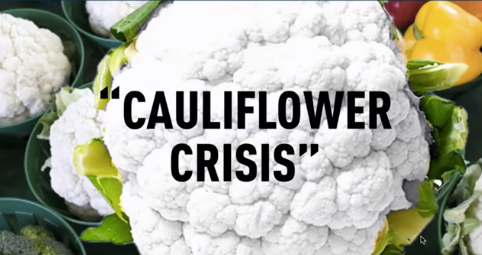
2016 has definitely been a year for trending food and nutrition issues! Here’s our recap of the top three nutrition headlines of the year plus what you can expect in 2017.
1. CAULIFLOWER CRISIS
Who can ever forget the $8 sticker shock on a head of cauliflower in January?! It became the poster child for rising food prices in Canada. According to the CBC, the price of fresh veggies rose by 13% in the past two years.
What to expect in 2017: The average Canadian family can expect to pay up to $420 more for food next year, according to Canada’s Food Price Report, an annual publication by researchers at Dalhousie University in Halifax. The price of meats, fish, seafood and fresh vegetables may rise as much as 4 to 6 percent. Lead author Sylvain Charlebois points to weather disruptions caused by La Nina, energy related costs and the tanking Loonie as factors affecting the price hikes.
What you can do: Look at grocery store flyers and use e-coupons. Plan your meals and plan to use the leftovers too.
2. INTERNATIONAL YEAR OF PULSES
Declared by the United Nations, the International Year of Pulses successfully raised our awareness of pulses and their many health benefits. Chef Michael Smith, Canada’s ambassador of the International Year of Pulses, kicked off the year with an invitation for all of us to take the Pulse Pledge and eat pulses at least once a week for 10 weeks.
What to expect in 2017: The buzz about pulses will continue, starting with Global Pulse Day which occurs January 18th of every year. It’s a global event to celebrate pulses and continue the momentum of the 2016 International Year of Pulses. With rising food costs, look to economical and versatile pulses to be a staple on your grocery list.
What you can do: Plan to eat at least one meatless meal each week using beans, peas, lentils or chickpeas.
3. SUGAR TAX
In February, the Dietitians of Canada released a position statement calling for a 10-20% excise tax on sugar-sweetened beverages. Drinking sugar-sweetened beverages such as soft drinks, fruit drinks, sports drinks, energy drinks and specialty coffee / tea beverages seems to be linked to excess weight in both kids and adults. In March, the Senate Report on Obesity also recommended a new tax on sugar-sweetened and artificially-sweetened beverages as one of many efforts to fight obesity in Canada.
What to expect in 2017: Sugar will continue to be under fire. In his Spring 2016 budget speech, Canadian Finance Minister Bill Morneau pledged to help families make better choices, including actions to include more information about added sugars on food labels. Earlier this month, Health Canada opened a public consultation about its proposed front-of-package nutrition labels. For the first time ever, sugar would be called out as one of the three nutrients that can negatively affect our health if consumed in excess. Health Canada proposes to set the % Daily Value (%DV) for total sugars (natural and added sugars) at 100 grams per day. Under these proposed new labelling regulations, foods which contain 15 grams or more of total sugars per serving would be considered “high in sugars” and carry a warning symbol.
What you can do: Share your opinions about nutrition labelling. Complete this brief consumer questionnaire and / or complete the technical questionnaire both by January 13th, 2017. This is YOUR chance to help shape the future of nutrition labelling in Canada.
Have questions about upcoming trends or how Health Canada’s proposed front-of-package labelling may affect your business? We can help. Contact us at: Info@NutritionForNonNutritionists.com